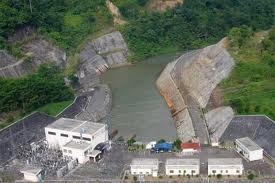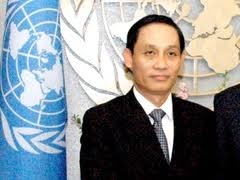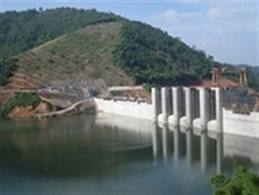Vietnam
Suu Kyi appeals for dam project review on ecological grounds
Burma's pro-democracy leader Aung San Suu Kyi appealed for a review of the ongoing dam projects in Kachin State.
Suu Kyi appeals for dam project review on ecological grounds
Burma's pro-democracy leader Aung San Suu Kyi appealed for a review of the ongoing dam projects in Kachin State.
Lao consumers can pay electric bills at BCEL
The Bank Pour Le Commerce Exterieur Lao will now accept electric bill payments for Elecitricite du Lao.
Small-scale hydro plant to boost Lao national power grid
National Consulting Group will establish a power company in Vientiane and an office branch in Saravan province to operate the Houay Por hydropower plant construction project.
Laos seeks new investors for 4 Saravan hydropower projects
Saravan provincial authorities will cancel four of nine planned small-scale hydropower plant projects due to lack of progress for almost 18 months after investors signed an MoU with the government.
GE to supply custom-designed fixed series capacitor banks to Vietnam
Vietnam is now forecasting a 7.5% to 8% annual economic growth over the next five years.
Chinese consortium gets EPC contract for Vietnamese coal-fired plant
Vietnam Electricity awarded the Chengda-Dec-Swepdi-Zepc consortium an engineering, procurement and construction contract to build the 1,245MW Duyen Hai 3 thermal power plant in Tra Vinh province, Vietnam.
Energy fund to ease govt control on Vietnam power industry
Saigon Asset Management Corp. plans to raise $300 million for an energy fund that would be the country’s largest.
Vietnam supports nuclear non-proliferation
Vietnam persists in supporting efforts against proliferation of nuclear weapons and all other weapons of mass destruction towards full disarmament, said Ambassador Le Hoai Trung. Ambassador Trung, Head of the Delegation of Permanent Representatives of Vietnam to the UN, was speaking at the July 27-28 UN General Assembly plenary meeting on revitalising the Conference on Disarmament (CD) in New York. As an active member of the UN, Vietnam has participated in and seriously fulfilled its obligations to significant international treaties on nuclear disarmament and non-proliferation, the ambassador said. In Southeast Asia, Vietnam is closely cooperating with ASEAN countries and other partners in implementing Treaty on Nuclear Weapon Free Zone, contributing to maintaining regional peace and security. The diplomat praised CD’s previous contributions and recognised recent progress in disarmament, naming the effectiveness of the new Strategic Arms Reduction Treaty (START) between Russia and the US in February this year and the success of the conference reviewing the treaty on non-proliferation of nuclear weapon in May 2010. Ambassador Trung called on CD members to early approve a working programme and set up a negotiating mechanism for four major pillars of the agenda: nuclear disarmament, ensuring nuclear security for nations without nuclear weapons, cutting down the production of nuclear fission substance and preventing an arm race in the universe with priority giving to nuclear disarmament. The strengthening of peace and international security will create an essential environment for disarmament to progress, Trung said.
Vietnam allocates VND929,700B for electricity development plan
Vietnam's electricity sector will increase the capacity of power supply in the north, central and southern regions to meet domestic consumer demands.
Vietnam's hydropower plants link with national grid
Turbine Unit No. 2 of the Dong Nai Hydropower Plant 3 with a capacity of 90MW has officially linked up with Vietnam's national grid.
The development of renewable energy in Vietnam
Vietnam has been rated as a country rather rich in clean renewable energy resources, but the application of renewable energy technologies in Vietnam is still its infancy with so many restraints. According to "Vietnam’s Strategy for National Energy Development to 2020 and Vision to 2050", approved by the Prime Minister in 2007, the targets to be achieved for new and renewable energy sources are still modest (accounting for about 5% of the total primary commercial energy by 2010 and 11% by 2050). Meanwhile the demand for energy is growing at a dizzying rate in Vietnam. Lighting system using renewable energy in Hoa Lac High Tech Park According to statistics from the Ministry of Industry and Trade, the growth rate of energy demand in Vietnam is increasing at twice the rate of the GDP growth. Meanwhile, in developed countries, this ratio is below 1. Energy consumption in Vietnam has been increasing, nearly five times in the period from 1990 to 2004 (from 4.21 million tons of oil equivalent to 19.55 million tons) with an annual average growth in this period of 11.7%. It is expected that Vietnam will become the energy importer by 2015. In the context that the domestic fossil fuels are being depleted day by day, the oil prices are rising higher and higher, and the dependence on world energy prices is becoming heavier and heavier, it is increasingly difficult to meet the domestic energy demand and this is becoming a major challenge. Therefore, "the considering of exploitation of renewable clean energy sources is of paramount importance in terms of economic, social, food security and sustainable development," said Deputy Minister of Industry and Trade Nguyen Nam Hai at a seminar recently held in Hanoi on renewable energy recourses. He also said "Vietnam is a country rather rich in renewable clean resources, thus making it possible to replace fossil energy sources and reduce impact on environment." Great Potential According to Mr. Le Tuan Phong, Deputy Director of the Department of Energy (Ministry of Industry and Trade), Vietnam has about 2000-2500 hours of sunshine annually with an average of about 150kCal/cm2, equivalent to about 43.9 million tons of oil /year. Meanwhile, wind energy also shows a rather great potential for various possible generating capacities, specifically, about 800-1400 kWh/m2/year on land, about 500-1000 kWh/m2/year in the coastal areas, the highlands and the south, and less than 500 kWh/m2/year elsewhere. Energy equivalent of biomass is about 43-46 million tons, of which 60% comes from wood waste and 4% from agricultural waste. 28177b7ac_gialai260411.gif Application of solar energy by a business Regarding the Red River Delta region alone, where the potential of wind energy and solar energy is modest due to climatic factors, various surveys show that geothermal energy is relatively impressive. According to the research team, which consisted of Dr. Doan Van Tuyen, Dinh Van Toan and Nguyen Duc Loi from Geological Institute (Academy of Science and Technology of Vietnam), there are signs indicating great potential of geothermal, including geothermal basin of Southeast - Northwest region with temperature reaching 160oC at a depth of 4 km (capable of generating electricity at about 1.16% of total electricity production in Vietnam in 2006); the geothermal fault zone of Song Lo-Vinh Ninh with average temperature of about 114oC; geothermal water sources in Hung Ha, Phu Cu, Hai Duong, Ba Vi (Ha Noi) with temperatures of 40-50oC respectively… According to calculations by scientists, if in Hanoi alone geothermal is used for air conditioning, it will possible to save about 800 billion VND a year and prevent about 252,000 tons of CO2 from being released into the environment. Besides, projects of exploitation and use of hot water at the temperatures of 40-50oC in the Red River Delta is quite feasible in developing new urban areas, tourist and recreation parks, resorts ... Initial research studies Although not properly invested in, renewable energy resources have already attracted the attention of several research institutions in the country. Dr. Nguyen Chanh Khe from for the Research and Development Center (SHTP laps) said that there had been some research studies carried out at the University of Natural Sciences in Ho Chi Minh City on Gratzel solar cells with efficiency of 6%, while solar cells of the same kind on the market had the efficiency of 11%. "At present, solar cell chips are mainly imported from Germany and France and we only have been able to implement the packaging of these products," said Dr. Khe. a0c555c5c_pin_mat_troi_20.jpg The grid-connected solar cell system installed on the roof of the headquarter building of the Ministry of Industry and Trade The common challenge for researches in Vietnam now is the high cost of materials, therefore it is hard for products made in Vietnam to compete with imported ones. Meanwhile, scientists such as Nguyen Tien Khiem, Ngo Quy Them (from the Mechanics Institute) and Do Dinh Khang (from Technology Development Company) and Vu Anh Tuan (Yen Dong Ltd. Company) released a report on "The Amorphous Silicon Solar Cell Technology and Applicability in Vietnam”. According to this study, Vietnam is one of those countries lying in the most sunlight-getting areas in the solar radiation map of the world due to its coastline of more than 3,000km. In the situation that there are thousands of inhabited islands with numerous areas where the grid can not reach, the on-the-spot use of solar energy to replace conventional energy sources is an expedient strategy which is of great significance in terms of economy, cultural education, and national security. According to the research team, the application of solar energy in Vietnam has not yet developed because of many reasons, the main of which is that the price of solar power is much higher than those of hydro power and thermal power. Many advanced countries such as the U.S. and Switzerland are pioneering in improving technologies of manufacturing solar cells with low costs to reduce product prices. One of the research orientations is to find out methods of developing amorphous silicon solar cells. For Vietnam, also according to the research team, the development of amorphous silicon solar cell technology can be considered an optimal solution, suitable for a long stretching country with many coastlines. "The cost of amorphous silicon solar cell in the world is only about $1/wp while that of a crystalline silicon cell is 5-6 times higher," said the research team. One of the advantages of amorphous silicon solar cell technology is that it can work effectively in harsh weather conditions, be it foggy or wet climates, or scorching sunshine or high temperatures. "We did an experiment for several days and observed that an amorphous silicon solar cell worked well in cloudy conditions," wrote the report by the research team. “Thus, if an amorphous silicon solar cell is used for lighting, with only about 10 hours exposure in a sunny day, it can maintain the lighting for the next 6 or 7 rainy days”, the report concluded. However, the limitation of the amorphous silicon solar cell technology is that the efficiency is still low, only about 10%. Another research study carried out by Dr. Nguyen Duc Nghia, Dean of the Department of Chemical Nanotechnology (Technological University) in collaboration with Nano Chemistry Department (Chemistry Institute) is the fabrication of organic solar cells . "The initial results opened up prospects for the mastery of the organic solar cell technology in the future," the research report by Dr. Nguyen Duc Nghia wrote. Organic solar cells have many attractive features such as low cost, flexibility, suitability with a large installation area, and natural colors. However, organic solar cells also have an important limitation, that is their low efficiency, only about one third that of crystalline silicon solar cells. Involvement of enterprises Besides scientists, there have been many private and foreign enterprises that are pioneering in exploiting the renewable energy market in Vietnam so far. In a joint venture, the Fuhrlaender AG Winpower of Germany and Vietnam Renewable Energy Joint Stock Company (REVN) are investing in building the first wind turbines in Binh Thuan, which are the most modern ones in Vietnam and have a generating capacity of 1.5 MW each. Earlier, the Phuong Mai Wind Farm 3 in Binh Dinh Province was inaugurated to exploit wind energy in Vietnam. It is expected in 2010, several wind farms will be put into operation in Da Lat City and Con Dao Island. However, experts said that most of the potential of wind energy (technology) in Vietnam has not been exploited yet. In April of 2009, the first solar cell plant built by the Red Sun Energy Join Stock Company of Ho Chi Minh City and its two partners including the Center for Energy Efficiency of Ho Chi Minh City (under Department of Science and Technology of Ho Chi Minh City) and Tan Ky Nguyen Co., Ltd. was inaugurated with an investment of $ 10 million. The event is expected to be a strong push for renewable clean energy market in Vietnam. Of its industrial production, the plant is planning to spare 40% for the domestic market and 60% for export to Europe and the Americas. According to experts’ assessment, this is the pioneering work in energy technology, laying the foundation for the solar cell technology in Vietnam. In the first stage, the plant, situated Duc Hoa District, Long An Province, will be able to provide solar cell panels, with a capacity of 80-165 Wp and efficiency of 16% each. The plant can supply an amount of products up to 5 mWp a year. Specially, the wholesale price of these products will be 30% to 40% lower than the retail one of the same products in the market at present. In the second stage, the plant will manufacture components from domestic raw materials for the assembly of solar cells. Besides, the plant will also design, assemble and manufacture energy saving products such as solar water heating system, energy saving light bulbs and other energy saving devices. Cenergy Power of the United States is also planning to access market in Vietnam. According to the company, it has been preparing dossier for operation in Vietnam. Its next plan is to open an office and training center in the first quarter of 2010. 30 Vietnamese technicians and engineers of solar energy will be given training by the company in second quarter of 2010 and by the end of the year, the number of trained technicians and engineers will increase to 100. Cenergy Power intents to transfer the solar energy technology, enhance capabilities and improve resources in solar energy projects, thus turning Vietnam into leading country in ASEAN regarding solar energy in terms of number of projects and trained personnel resources. Another company, which is named Kim Dinh International Group J.S.C., and based in Hanoi, aims to undertake activities not only in research and development of new and renewable energy recourses but also in provision of products and implementation of projects in this field, specifically, wind energy equipment; solar energy equipment; wind-solar energy combined systems; automatic-control telecommunication systems; energy solutions for remote areas, agro-forestry-fishery production and public lighting… A project which has been successfully implemented is the lighting system using wind and solar energy at the Lang-Hoa Lac Hi-tech Park. Thus, only in the field of renewable energy did one see the efforts made by private enterprises and scientists. According to an energy expert from Europe, in countries where renewable energy recourses have been well developed, governments provide funds for and are involved in large projects, including research and applications. For Vietnam, the limited budget from the Government for clean renewable energy resources is perhaps the largest obstacle preventing this type of energy from coming into life and thriving in Vietnam.
Honeywell wins $3m deal to automate offshore gas platforms in Vietnam
Bien Dong Petroleum’s gas platform is expected to provide up to 2b cubic meters of gasoline each year.
GE to power first wind farm in Vietnam's Mekong Delta
10 of its wind turbines will be generating 16 MW of power for the Bac Lieu Wind Farm.
ADB to assist Greater Mekong's biomass utilization for clean energy
ADB will help the Greater Mekong Subregion scale up the use of biomass waste in the agriculture sector to meet its growing need for clean energy.
AES-VCM gets loan for $1.95B Vietnam power plant
AES-VCM Mong Duong Power will construct Vietnam's largest private sector power plant, a $1.95 billion coal-fired plant, on a build-operate-transfer basis.
Vietnam power price to be quoted by the region
Vietnam's Ministry of Industry and Trade has proposed amending the Electricity Law so as to apply different power prices to each region.
Vietnam discusses role of the press in energy efficiency
A seminar was organized in Vietnam to promote the propagation and make a change in perceptions and actions of people on enhancing the efficient use of energy resources. It also intends to raise awareness of environment protection and in contributing to the implementation of the National Program on Energy Efficiency and Conservation.









 Advertise
Advertise



















